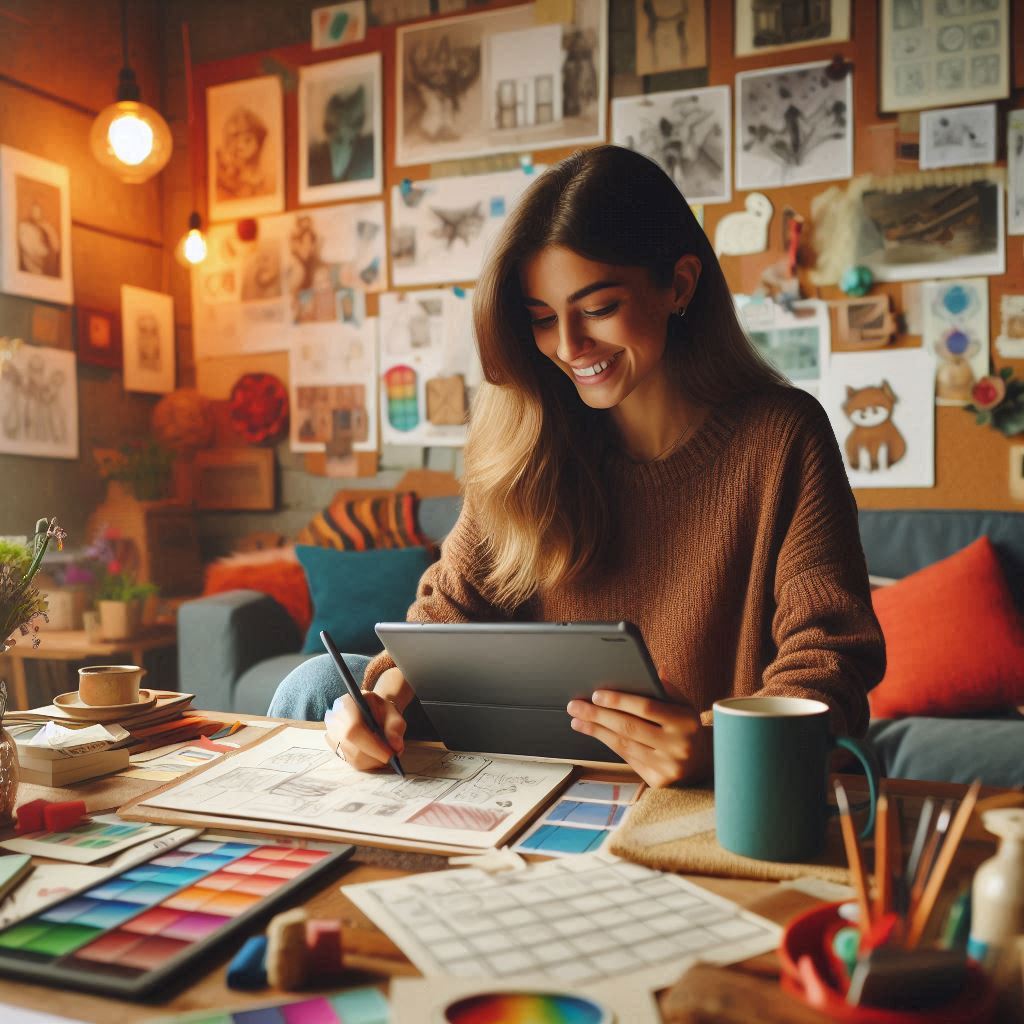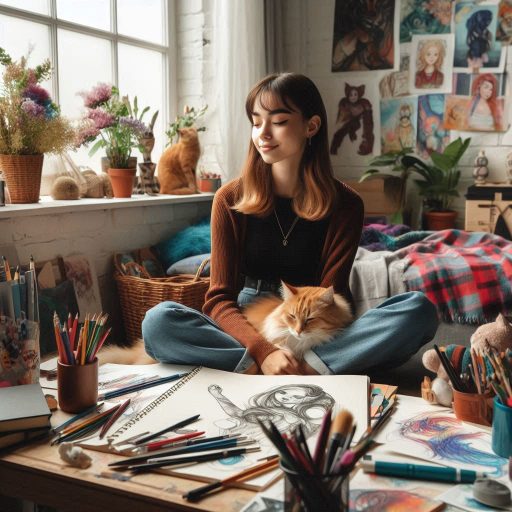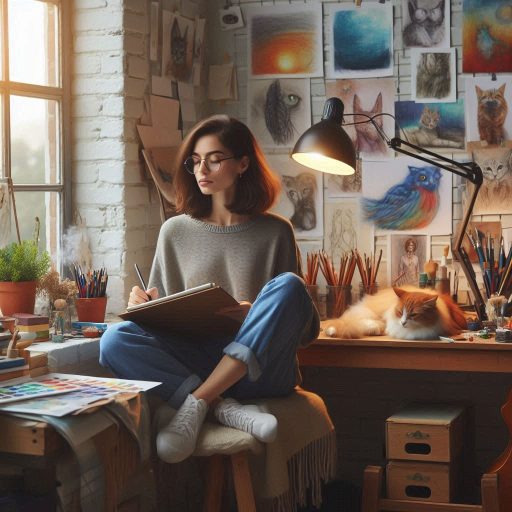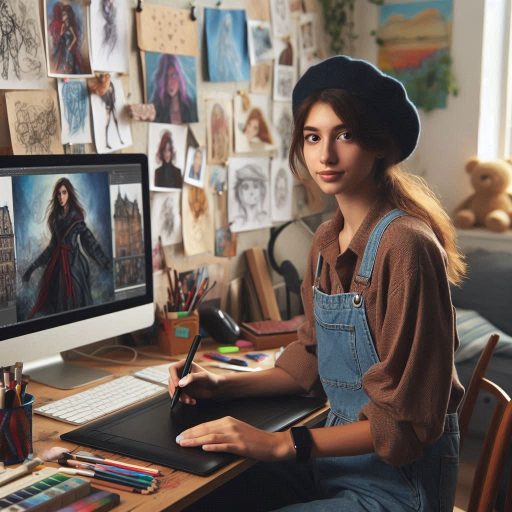Introduction
Concept art plays a crucial role in shaping the visual world of movies, video games, and animation.
It brings imaginative ideas to life, offering a glimpse into characters, environments, and worlds that don’t yet exist.
Concept artists are responsible for bridging the gap between creative vision and final production, working closely with directors and designers.
In this fast-paced industry, efficiency and creativity are essential.
The right tools and software can significantly enhance the artist’s ability to produce high-quality work.
With digital advancements, concept artists can sketch, render, and revise quickly, making their workflow more fluid.
Tools provide artists with precision, while software gives them flexibility in creating complex designs.
Whether it’s crafting 2D sketches or building 3D models, these tools empower artists to realize their visions efficiently.
In the highly competitive entertainment industry, mastering the right tools is often the difference between staying ahead or falling behind.
Thus, understanding and utilizing essential tools is fundamental for success in concept art.
Traditional tools for concept art
The use of pencil, paper, and markers in creating initial sketches and concepts
Pencil and paper remain the foundation of concept art.
These simple tools allow artists to quickly translate ideas into visual form.
Concept artists often begin their process with rough sketches on paper to explore various ideas.
The tactile connection between hand and paper enhances creativity, enabling a fluid development of concepts.
Using a pencil is ideal for quick, iterative sketching.
It encourages experimentation with forms and compositions, allowing concept artists to work freely without constraints.
The ability to easily erase and redraw encourages flexibility, helping artists refine their ideas.
The physical nature of paper sketches offers a tangible connection to the creative process.
Artists can physically manipulate, fold, or overlay sketches, which can lead to new ideas.
This hands-on interaction can lead to an organic flow of creativity, providing a foundation that can later transition into digital form.
Markers play a crucial role in bringing initial sketches to life.
Concept artists use markers to add bold lines, shading, and depth to their ideas.
By incorporating grayscale or colored markers, artists can enhance the visual dynamics of their sketches.
Markers help artists define the mood and tone of their concepts early in the process.
Markers are particularly useful for experimenting with light, shadow, and contrast.
They allow artists to quickly visualize different lighting scenarios and contrast effects.
By focusing on values early, artists can strengthen the impact of their designs when moving to the digital phase.
Traditional Tools Lay the Groundwork for Digital Art
Even in today’s digital world, traditional tools like pencils, paper, and markers provide an essential foundation.
Concept artists often transfer their sketches to digital platforms, refining them with advanced software.
The skills learned through traditional drawing techniques improve digital workflow and precision.
Artists trained with traditional tools develop strong observational and manual skills.
These skills enhance their digital work, giving them greater control over line work, shading, and composition.
A concept artist who masters pencil and marker sketching can effectively transition these techniques to a digital environment.
Traditional tools allow for freeform exploration without the distractions of software interfaces.
Artists can focus solely on their ideas, using quick sketches and marker shading to bring concepts to life.
This organic process helps establish a strong conceptual foundation that serves as a springboard for more detailed digital work.
Pencil, paper, and markers continue to play a critical role in concept art.
These tools encourage experimentation, provide tactile feedback, and help artists build strong foundations for digital work.
Traditional methods foster creativity and enable artists to develop their skills for a more refined digital process.
Read: Breaking Down Iconic Movie Costumes
Digital painting software
Adobe Photoshop: Industry Standard for Concept Artists
Adobe Photoshop remains a top choice for digital painting among concept artists.
Its intuitive interface and powerful tools make it indispensable.
The program offers a wide range of brushes, giving artists complete creative control.
Photoshop’s layering system is unmatched, allowing you to build complex images effortlessly.
The blending options help create smooth transitions between colors and textures.
You can adjust opacity and layer styles for greater flexibility in your designs.
Additionally, Photoshop supports custom brushes, allowing artists to create unique textures.
With easy-to-use shortcuts and customizable workspaces, it streamlines the creative process.
Corel Painter: Realistic Digital Painting Experience
Corel Painter is another essential tool for concept artists.
It focuses on replicating traditional art techniques in a digital format.
The software boasts an array of brushes mimicking oil paints, watercolors, and pastels.
With its advanced color blending options, Corel Painter offers a highly realistic painting experience.
The software’s brush engine gives you precise control over stroke and texture, enhancing artistic expression.
Its paper textures feature lets you replicate real-world canvases.
This attention to detail makes Corel Painter an excellent tool for artists seeking authenticity in their digital works.
Essential Features for Concept Artists
Both Adobe Photoshop and Corel Painter share key features that elevate them as must-have tools for concept artists.
Layering is one of the most critical functions, allowing artists to separate elements and adjust them independently.
Blending modes in both programs enable smooth transitions between colors, creating depth and atmosphere in your designs.
Customizable brushes let you craft textures that fit your specific needs.
Each software also provides excellent support for pressure-sensitive tablets, enhancing precision.
Together, these features give concept artists the freedom to explore, refine, and execute their creative visions.
Layering is fundamental to building complex compositions.
It lets you experiment with different design elements without affecting the rest of the artwork.
You can make adjustments at any stage, allowing for greater flexibility.
Blending is equally crucial as it enhances the visual flow of your designs.
By adjusting the opacity of layers, you can create more realistic textures.
Blending modes, such as Multiply and Overlay, further refine the color relationships in your work.
These options are essential for achieving professional-level results.
Whether you prefer Adobe Photoshop’s versatility or Corel Painter’s realism, both programs are essential for any concept artist.
They provide the tools necessary to create compelling, high-quality artwork.
Layering and blending options are especially critical for artists aiming to achieve depth, detail, and flexibility in their designs.
Selecting the right digital painting software will significantly impact your creative process and final output.
Read: Networking Events for Costume Designers
3D modeling tools
The importance of 3D modeling software like ZBrush and Blender in creating detailed concepts
3D modeling tools are essential for modern concept artists.
These tools allow artists to push the boundaries of creativity by providing new ways to visualize ideas in a three-dimensional space.
Among the most widely used are ZBrush and Blender.
ZBrush: Sculpting with Precision and Detail
ZBrush is a powerful tool that allows artists to sculpt highly detailed 3D models.
Its dynamic brush system lets you create organic shapes, intricate textures, and complex designs.
This level of control makes ZBrush an ideal software for creating characters, creatures, and environments with stunning realism.
Concept artists use it to experiment with forms and details that would be challenging to execute in traditional 2D illustrations.
ZBrush also offers the ability to handle high-polygon models, making it perfect for creating intricate concepts that require significant detail.
One of the most significant advantages of ZBrush is its ability to simulate real-world sculpting techniques.
The program mimics clay-like modeling, providing an intuitive experience for artists used to traditional media.
With ZBrush, you can manipulate surfaces at both macro and micro levels.
This helps you refine details and enhance the believability of your designs.
Blender: Versatility and Accessibility
Blender is another game-changing tool for concept artists.
It’s an open-source 3D modeling software with a versatile toolset.
From sculpting and texturing to animation, Blender allows artists to create everything from initial concepts to fully rendered scenes.
What sets Blender apart is its flexibility.
Artists can use it to develop simple blockouts or highly detailed renders, depending on the needs of the project.
For concept artists, Blender’s grease pencil feature stands out.
It allows you to sketch directly in 3D space, combining 2D and 3D workflows in a single platform.
This unique feature makes Blender an invaluable tool for artists who want to explore various perspectives quickly.
Blender’s powerful rendering engine, Eevee, enables real-time rendering, allowing artists to instantly see the effects of lighting, materials, and textures on their models.
This real-time feedback enhances the creative process and ensures a more fluid workflow.
Transform Your Career Today
Unlock a personalized career strategy that drives real results. Get tailored advice and a roadmap designed just for you.
Start NowHow these tools can help concept artists visualize their ideas in a three-dimensional space
Both ZBrush and Blender help concept artists visualize their ideas in three-dimensional space.
By doing so, they offer a deeper understanding of how designs will function in the real world.
3D modeling allows for the exploration of different angles, lighting setups, and even material properties.
These tools give artists a significant advantage in terms of precision and detail, helping them create more realistic and dynamic concepts.
The ability to work in 3D empowers concept artists to take their ideas further, leading to more innovative designs and effective visual storytelling.
Read: Building a Portfolio for Costume Design
Reference and Research Tools
Every concept artist needs a solid collection of reference and research tools.
These tools provide inspiration and help artists stay fresh with ideas.
By having access to vast image libraries and creative communities, artists can fuel their creativity and refine their designs.
Websites and resources where concept artists can find inspiration and reference material
Pinterest: The Endless Mood Board
Pinterest serves as a powerful visual search engine for concept artists.
It allows you to find an endless variety of images, color schemes, and visual ideas.
With Pinterest, you can organize boards for specific projects or themes, giving you quick access to mood boards whenever needed.
This convenience helps artists maintain focus while also expanding their creative horizons.
Plus, Pinterest’s algorithm will recommend images based on your previous searches, continually feeding you fresh content and ideas.
Pinterest’s collaborative nature also makes it a valuable platform.
Artists can share boards, exchange ideas, and collaborate remotely.
Whether you are working on character design or environmental art, Pinterest simplifies the process of gathering and organizing reference materials.
ArtStation: The Artist’s Hub
ArtStation is another essential tool for concept artists, offering a comprehensive platform for inspiration and exposure.
It features portfolios from professional artists, many of whom are leading experts in the field of concept art.
Browsing through these portfolios not only provides inspiration but also sets a benchmark for high-quality work.
Concept artists can follow their favorite creators, study their process, and gather valuable insights for their own projects.
Additionally, ArtStation regularly hosts challenges and competitions, encouraging artists to experiment and push their boundaries.
These events inspire artists to explore new styles and techniques, often leading to unexpected creative breakthroughs.
By participating in these challenges, concept artists can keep their skills sharp while expanding their portfolio.
Websites for Research and Inspiration
In addition to Pinterest and ArtStation, there are many other resources concept artists should explore.
Websites like Unsplash, Pexels, and DeviantArt provide high-quality reference images and inspiration for a wide range of styles and subjects.
Unsplash and Pexels are excellent sources for realistic photography, while DeviantArt offers more stylized and fan-created content.
Flickr and Google Images can also serve as helpful research tools.
These platforms offer a variety of photos that are perfect for studying lighting, anatomy, landscapes, and textures.
Using these sites, artists can deepen their knowledge and gather unique references that elevate their work.
Benefits of using tools like Pinterest and ArtStation for idea generation and research
Using reference tools streamlines the creative process and boosts productivity.
Having easily accessible reference images helps you avoid creative blocks and enhances the visual depth of your concepts.
In addition, consistent research into different styles and subjects can prevent stagnation and keep your ideas fresh.
These tools ensure that your work remains innovative, detailed, and compelling.
Read: Essential Skills for Aspiring Costume Designers

Collaboration Tools
Collaboration is key in the world of concept art, where multiple professionals often work together on a single project.
Efficient communication and file sharing ensure that all team members stay on the same page.
To streamline this process, concept artists use collaboration tools that foster seamless teamwork.
Two of the most popular platforms for sharing and collaborating on artwork are Dropbox and Google Drive.
These tools simplify the workflow and enhance communication among concept artists and other professionals.
Platforms like Dropbox and Google Drive for sharing and collaborating on artwork with team members
Dropbox: Reliable Cloud Storage for Teams
Dropbox is one of the most widely used cloud storage platforms for artists.
It allows concept artists to upload, store, and share their work with others in real-time.
Dropbox makes it easy to manage files, ensuring everyone involved can access the latest versions of a project.
Team members can view and comment on files without altering the original artwork.
This creates an organized workflow where feedback is clear, and changes are trackable.
Dropbox also supports high-resolution images, so artists can share large files without compromising quality.
Google Drive: Integrating File Sharing with Collaboration
Google Drive offers more than just file storage.
Its integration with Google Docs, Sheets, and Slides allows for dynamic collaboration.
Concept artists can share their work with team members and give real-time feedback on each other’s files.
Additionally, the ability to control access levels ensures the right people can view, edit, or comment on specific documents.
For larger teams, Google Drive’s collaborative features can save time and prevent miscommunication.
The built-in commenting system allows for instant feedback, helping teams make quick decisions on artwork revisions.
Streamlining the Workflow and Facilitating Communication with Cloud-Based Collaboration
Dropbox and Google Drive help concept artists work more efficiently by reducing the time spent on manual file transfers.
With automatic syncing, files update across devices in real-time, ensuring the latest version is always accessible.
This prevents any confusion over outdated files or missing details, which can slow down a project.
Artists can focus on the creative process while the platforms handle file organization and storage.
Additionally, the ease of sharing across various devices and locations enhances flexibility, allowing remote teams to collaborate as if they were in the same room.
Collaboration tools like Dropbox and Google Drive foster smooth communication between concept artists, clients, and other professionals.
These platforms allow for easy integration of feedback from non-designers, such as producers or clients, without interrupting the creative flow.
Sharing artwork drafts or mood boards with collaborators becomes effortless, allowing for quicker decision-making and revisions.
Additionally, the ability to work within a shared space ensures that all feedback, updates, and changes are accessible to everyone involved.
This level of transparency ultimately reduces misunderstandings and delays in production.
By using these platforms, concept artists can maintain a streamlined workflow while keeping communication lines open.
Animation Software
Use of animation software like Toon Boom and Adobe Animate in creating dynamic concept art
Animation software plays a vital role in concept art, especially when illustrating dynamic movement.
Tools like Toon Boom and Adobe Animate offer powerful features that help artists bring their creations to life.
These platforms allow concept artists to create fluid animations that enhance the visual storytelling of their designs.
Toon Boom
Toon Boom is an industry-standard animation tool widely used in film, television, and video games.
Concept artists often use it to animate characters, environments, or even intricate object designs.
By adding motion, they can showcase how elements within a scene interact with each other.
The software provides vector-based drawing tools, which offer flexibility and scalability without losing image quality.
Concept artists can experiment with various animation styles, including 2D animation and cut-out techniques, to highlight movement and depth.
This dynamic approach helps them convey the intended energy of a design to clients and collaborators.
Toon Boom also features a bone-rigging system that allows artists to control the movement of different parts of a character.
This tool is essential when demonstrating how a character would move or behave in various scenarios.
Animating these features provides a clearer understanding of the design and its potential, ensuring alignment with the project’s overall vision.
Adobe Animate
Adobe Animate is another widely used animation tool that concept artists rely on to create interactive elements.
This software allows artists to develop rich animations with intuitive controls.
Using frame-by-frame animation techniques, artists can create realistic motion that shows how characters, props, and environments interact.
Adobe Animate provides a user-friendly interface that supports both vector and bitmap graphics, enabling concept artists to switch between styles seamlessly.
Artists can animate subtle facial expressions, body language, or even environmental elements like wind or water.
This added layer of interaction helps clients visualize how their ideas will perform in real-world applications.
One of the standout features of Adobe Animate is the timeline function, which enables artists to control the sequence and timing of animations with precision.
Concept artists use this feature to refine the flow of movements, ensuring they appear natural and believable.
By animating key elements, they can effectively showcase how different aspects of their design will work in motion, elevating the design’s presentation.
How these tools can help concept artists showcase movement and interaction in their designs
Incorporating animation into concept art allows artists to communicate their vision more clearly.
Tools like Toon Boom and Adobe Animate help concept artists illustrate how designs interact and move.
Animation showcases potential dynamics that static images can’t capture, making it easier for clients to grasp the complete vision of a project.
Whether demonstrating character movement or environmental interaction, these tools give concept artists the ability to bring designs to life, making them more engaging.
Color Management Tools
The Importance of Color in Concept Art
Color is a powerful element in concept art.
It evokes emotion, sets the tone, and enhances storytelling.
Concept artists rely on color to guide viewers’ attention and create visual harmony.
The right color choices can transform a piece from ordinary to extraordinary, making color management essential for achieving artistic goals.
Without effective color selection, even the most skilled artwork can feel disjointed or flat.
Showcase Your Business Today
Reach thousands of readers actively exploring professional services. Publish your business profile and grow your audience now.
Publish NowRole of Color Management Tools in Concept Art
Color management tools simplify the process of selecting and organizing colors.
Tools like Adobe Color and Coolors allow artists to experiment with different hues and combinations.
These tools help artists visualize how colors interact before they even begin the artwork.
By using such tools, concept artists can save time while ensuring their color palettes align with the intended mood and story of their work.
Adobe Color is one of the most popular color management tools.
It enables artists to create and explore custom color schemes quickly.
The tool offers several modes, like analogous, complementary, and triadic color schemes.
This helps concept artists experiment with various palette styles and choose the most suitable one for their project.
Adobe Color also allows users to extract color themes from existing images, aiding in the creation of cohesive palettes that work well with existing designs.
How these tools can help concept artists create harmonious color palettes and enhance the visual impact of their artwork
Coolors is another powerful tool for concept artists.
It offers a fast and easy way to generate color schemes.
The tool provides a range of pre-built palettes and customization options.
Artists can lock certain colors and shuffle the rest to discover new combinations.
This flexibility encourages experimentation and innovation.
Coolors also allows for seamless export to other design programs, streamlining the workflow.
Harmonious color palettes are crucial to producing visually appealing concept art.
Both Adobe Color and Coolors assist in generating palettes that work well together.
They allow artists to explore various combinations, ensuring the final artwork is not just visually striking but also balanced.
These tools eliminate much of the guesswork from the color selection process.
By using a structured approach, artists can develop palettes that complement each other and enhance the artwork’s overall impact.
Using tools like Adobe Color and Coolors helps concept artists create artwork with a higher visual impact.
These tools ensure that colors are cohesive and harmonious, enhancing the storytelling aspects of the artwork.
A well-curated color palette can make an image more engaging and memorable.
With these color management tools, artists can focus on their creativity, knowing that their colors are optimized for maximum impact.
Color management tools are vital for creating stunning concept art.
Adobe Color and Coolors help artists refine their palettes, saving time and improving the quality of their work.
Conclusion
In this blog, we explored essential tools and software for concept artists.
Each tool plays a vital role in enhancing creativity.
Adobe Photoshop stands out for its versatility in digital painting.
Procreate offers intuitive features that streamline the drawing process on iPads.
Blender provides powerful 3D modeling capabilities, allowing artists to visualize concepts effectively.
ZBrush excels in sculpting detailed characters and environments.
Clip Studio Paint is perfect for illustrations and comic art.
For those seeking project management, Trello or Asana keeps tasks organized and on track.
Each software has unique strengths that cater to various artistic needs.
As a concept artist, embrace experimentation with different tools.
Each artist’s workflow is distinct, so find what resonates with you.
Don’t hesitate to switch between software to discover new techniques.
Try free trials to explore features without commitment.
Your artistic journey flourishes when you adapt tools to your creative process.
Remember, the right tool can elevate your work and enhance your skills.
Stay curious, and let your creativity thrive as you refine your craft.
[E-Books for Sale]
The Big Book of 500 High-Paying Jobs in America: Unlock Your Earning Potential
$19.99 • 500 High-Paying Jobs • 330 pages
Explore 500 high-paying jobs in America and learn how to boost your career, earn more, and achieve success!
See All 500 High-Paying Jobs of this E-Book
1001 Professions Without a Degree: High-Paying American Jobs You Can Start Now
$19.99 • 1001 Professions Without a Degree • 174 pages
Discover 1001 high-paying jobs without a degree! Unlock career tips, skills, and success strategies for just $19.99!




